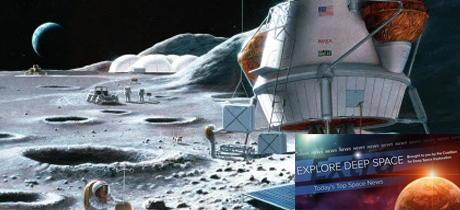In Today’s Deep Space Extra… More details emerge regarding NASA’s plans for a sustained return to the Moon with astronauts. Japan prepares to participate in the assembly of NASA’s lunar orbiting Gateway.
Human Space Exploration
NASA’s full Artemis plan revealed: 37 launches and a lunar outpost
Ars Technica (5/20): More details emerge regarding Artemis, the NASA plan announced nearly two months ago to accelerate a human return to the surface of the Moon from 2028 to 2024 and return subsequently with landers to establish an outpost for longer duration stays. The full cost and source of the funding remain unclear and a potential obstacle among lawmakers responsible for the funding.Japan to sign on to U.S. Moon exploration platform
Nikkei Asian Review (5/20): When they meet next week, President Trump and Japanese Prime Minister Shinzo Abe are expected to sign an agreement for Japan’s participation in NASA’s lunar orbiting, human tended Gateway. Japan is expected to contribute to the Gateway’s life support systems and re-supply needs. Canada has already signed on as a participant in the assembly of the way point for astronauts headed to the lunar surface.
Have Moonsuit, will travel
The Space Review (5/20): NASA’s plans for an accelerated human return to the lunar surface will require something suitable to wear as well as a powerful rocket to begin the journey, a capsule like habitat to start and end the flight and a lander. The Apollo astronauts who trained for and walked on the Moon have had something to say about the mobility, comfort and ease of operations of their space suits.
Achieving Bezos’ bold vision of space settlement requires bold policy direction (Op-ed)
SpaceNews.com (5/20) Those who shape U.S. space policy need to make bold changes, advances that help pave the way for human space settlement, writes Steve Wolfe, deputy executive editor of SpaceCom and chair of the International Space Development Congress policy forum on space settlement.
Space Science
What keeps Pluto’s ocean from freezing?
CNN: (5/20): NASA’s New Horizons mission, which conducted the first ever close flyby of distant Pluto in July 2015, is confronting scientists with another mystery, a liquid ocean beneath an icy shell, in need of an explanation. It appears a layer of gas between the liquid and the ice may serve as insulation to keep the water from freezing, according to findings published in the journal Nature Geoscience.
NASA’s Juno finds changes in Jupiter’s magnetic field
NASA/Jet Propulsion Laboratory (5/20): Juno, NASA’s long running mission to Jupiter, has detected changes in the giant planet’s internal magnetic field. They may help to explain changes underway beneath Jupiter colorful cloud cover as well as changes underway in the Earth’s own magnetic field, according to scientists.
Other News
The launch industry prepares for a shakeout
Coalition Member in the News – United Launch Alliance
The Space Review (5/20): Changes may be coming to the space launch services industry. As more providers are entering the market, the incumbents are asking if there is enough business to go around despite an enthusiasm for new small satellite operations. Tony Bruno, CEO and president of United Launch Alliance (ULA), was among those addressing the topic at last week’s Satellite 2019 conference in Washington. With expectations of 30 to 35 launches annually, there may be room for no more than companies, he said.
House appropriators deny Space Force funding, call on DoD to study alternatives
SpaceNews.com (5/19): The U.S. House Appropriations Committee has balked at a $72.4 million request to establish a Space Force headquarters and is urging the Pentagon to look at alternatives. The action is separate from ongoing deliberations among those in the House and Senate responsible for authorizing the creation of a U.S. Space Force as a new branch of the military. The Committee is scheduled to markup a Defense spending bill on Tuesday.

